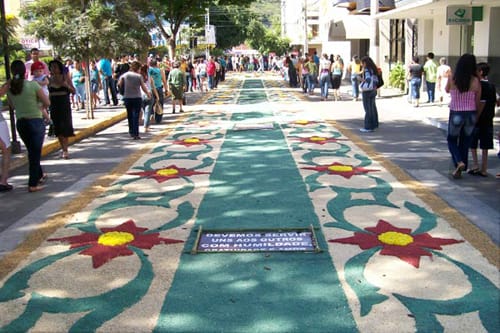For many years now it is the official celebration of Corpus in the diocese of Cachoeiro de Itapemirim. It’s part of the cultural calendar of the State of Espirito Santo. It aspires to be included in the top ten religious festivals of the whole of Brazil. On the eve of celebrating its ruby jubilee the Corpus procession of Castelo had become a national attraction.
In this small city to the south east of Brazil, some 143 km from Vitoria, the State capital and 330 from Rio de Janeiro. Corpus Christi was celebrated this year on the 23rd June, like the rest of the country. The previous day and all through the night a host of workers got to work “painting” the tapestries on the streets around the main parish church dedicated to our Lady of the Rock (Penha). The following day, Masses began to be celebrated from seven in the morning onwards. The main Mass is at 4pm normally presided over by the bishop. This year, however, because there is no bishop, the administrator, Antônio Tatagiba, stood in and celebrating the Eucharist and heading the procession which follows on straight afterwards. Both were transmitted entirely by Gazeta TV, the regional television channel
50 years of Recollect tapestries.
This parish, the only one in Castelo till very recently, is celebrating sixty years of existence. From its beginnings, it has been run by the Recollects. Sixty years ago due to the initiative of a Sister of Charity, Sr Zuleide, a small flower tapestry with geometric designs, marked out one of the stations in the Corpus Christi procession. In 1964, with the support of the Augustinian Recollect Fr. José Osés, who was then the parish priest, a “tapestry” was made up in the centre of the Town. The following year more streets along the procession route were similarly decorated.
Today it is a real spectacle. Hundreds of people are involved in making the highly coloured carpet that is more than a kilometre long. The designs are worked on the whole year round, with extremely varied motifs, from religious symbols and themes – especially Eucharistic ones – to those with a social or ecological character. Every type of material is used: paper, cloth, flowers, plastic sand stones, sawdust, bottle caps, and coffee bean husks…. And, from time to time, there are surprising references to the history of the OARs in the parish and town; a mention of Fr. José Osés who was parish priest for many years, or fray Manuel Simón, who has a very lively cultural organization in Castelo named after him. These Eucharistic “tapestries” are a collective art form that lasts but one day, destined to be a carpet for the Blessed sacrament to tread on. The project and preparation of months, the efforts of the local population, the aid given by the local Council and the parish, all become an offering to Our Lord in the Blessed Sacrament who takes a walk through the street of Castelo blessing its people.


